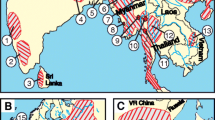Abstract
In relict Lakes Baikal, Biwa and Khubsugul three orders: Hydrida, Athecata and Limnomedusa (?) of the class Hydrozoa were found. In Lake Baikal, only representatives of Hydrida, such as Pelmathohydra baikalensis (endemic of Lake Baikal), P. oligactis and Hydra circumcincta were found (the last two species had not been found there before. Recent studies of the phylum Cnidaria in Lake Biwa showed the presence of Pelmatohydra oligactis and a representative of the family Clavidae which has been treated as a new species, Pachycordyle kubotai. In Lake Khubsugul a single representative of Hydrida has been found so far which is suggested to represent a new species of Pelmatohydra. According to techniques described earlier air-dried chromosome slides were prepared. The karyotype of P. kubotai were studied using conventional chromosome staining (by 6–10% Giemsa in the Sørensen’s buffer, pH 6.8), whereas karyotype of P. baikalensis was studied using conventional and C-banding techniques. C-banding to reveal highly repeated DNA followed the protocol by Sumner (1972).
Similar content being viewed by others
References
Anokhin B. A. (2002) Redescription of the endemic Baikalian species Pelmatohydra baikalensis (Cnidaria: Hydrozoa, Hydrida, Hydridae) and assessment of the hydra fauna of Lake Baikal. Ann. Zool. 52: 475–481.
Anokhin B. A., Kuznetsova V. G. (1999) Chromosome morphology and banding patterns in Hydra oligactis Pallas and H. circumcincta Schulze (Hydroidea, Hydrida). Folia Biol. (Krakow) 47: 91–96.
Campbell R. D. (1999) The Hydra of Madagascar (Cnidaria: Hydrozoa). Ann. Limnol. 35: 95–104.
Holstein, T., 1995. Cnidaria: Hydrozoa. In: Susswasserfauna von Mitteleuropa. Gustav Fisher Verlag. Stuttgart, Jena, NY.1/2 + 3: 110 pp.
Negoro, K., 1982. The plankton of Lake Biwa. The Shiga Prefectural Institute of Public Health and Environmental Science.
Schulze P. (1927) Zur Kenntns und geographischen Verbreitung der Susswasserpoplypen. Zool. Anz. 74: 129–141.
Stepanjants, S. D., 1994. Cnidaria. in Key to Freshwater Invertebrates of Russia and Adjacent Lands. Vol. 1. The Low Invertebrate. St.Petersburg: 12–16: 162–169 (in Russian).
Stepanjants, S. D. & B. A. Anokhin, 2001. Hydrida (Cnidaria:Hydrozoa). In: Lake Baikal and Its Catchment Area: In 2 volumes – Novosibirsk: Nauka. Vol. 1: Lake Baikal, Book 1 – 432 p – (Guides and Keys to Identification of Fauna and Flora of Lake Baikal); chapter 2: 192–194 (in Russian).
Stepanjants S. D., Anokhin B. A., Kuznetsova V. G. (2000a) Hydrida composition and place in the System of Hydroidea (Cnidaria: Hydrozoa). Trudi Zool. Inst. Ross. Akad. Nauk 286: 155–102.
Stepanjants, S. D., A. O. Timoshkin, B. A. Anokhin & T. O. Napara, 2000b. A New Species of Pachycordyle (Hydrozoa, Clavidae) from Lake Biwa (Japan), with Remarks on this and Related Clavid Genera. In: Mills, C.E., F. Boero, A. Migotto & J. M. Gili (eds), Trends in Hydrozoan Biology – IV. Sci. Mar. 64: 225–236.
Sumner A. T. (1972) A simple technique for demonstrating centromere heterochromatin. Cell. Res. 75: 304–306.
Swarczewsky, B., 1923. Sketches about Hydraria. Proc. Professors & Teachers Irkutsk Univ. 4: 9–102 (in Russian).
Author information
Authors and Affiliations
Corresponding author
Rights and permissions
About this article
Cite this article
Stepanjants, S.D., Anokhin, B.A. & Kuznetsova, V.G. Cnidarian fauna of relict Lakes Baikal, Biwa and Khubsugul. Hydrobiologia 568 (Suppl 1), 225–232 (2006). https://doi.org/10.1007/s10750-006-0310-1
Issue Date:
DOI: https://doi.org/10.1007/s10750-006-0310-1




